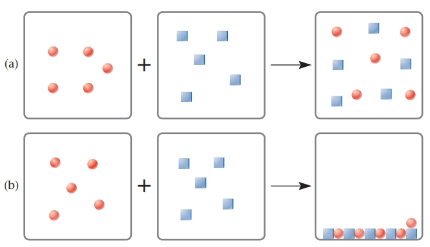
Concept explainers
Assuming that circles represent cations and squares represent anions, match the incomplete net ionic equations to their pictorial representations.


(1)
(2)
Trending nowThis is a popular solution!

Chapter 4 Solutions
Student Solutions Manual For Masterton/hurley's Chemistry: Principles And Reactions, 8th
- Write a balanced equation for the reaction of hydroiodic acid, HI, with calcium hydroxide, Ca(OH)2. Then, write the balanced complete ionic equation and the net ionic equation for this neutralization reaction.arrow_forwardIn each of the following cases, aqueous solutions containing the compounds indicated are mixed. Write balanced net ionic equations for the reactions that occur. (a) CaCl2 + Na3PO4 (b) iron(III) chloride and potassium hydroxide (c) lead(II) nitrate and potassium chloridearrow_forwardEach box represents a tiny volume in an aqueous solution of an ionic compound. (For simplicity, water molecules are not shown.) Which box represents: (a) Na2CO3, (b) NH4NO3, (C) CaBr2? Explain your reasoning.arrow_forward
- Vitamin C is ascorbic acid, HC6H7O6, which can be titrated with a strong base. HC6H7O6(aq) + NaOH(aq) NaC6H7O6(aq) + H2O() A student dissolved a 500.0-mg vitamin C tablet in 200.0 mL water and then titrated it with 0.1250-M NaOH. It required 21.30 mL of the base to reach the equivalence point. Calculate the mass percentage of the tablet that is impurity.arrow_forwardThioridazine, C21H26N2S2, is a pharmaceutical agent used to regulate dopamine (Dopamine, a neurotransmitter, affects brain processes that control movement emotional response, and ability to experience pleasure and pain.) A chemist can analyze a sample of the pharmaceutical for the thioridazine content by decomposing it to convert the sulfur in the compound to sulfate ion. This is then trapped as water-insoluble barium sulfate (see Figure 4.4). SO42(aq, from thioridazine) + BaCl2(aq) BaSO4(s) + 2 Cl(aq) Suppose a 12-tablet sample of the drug yielded 0.301 g of BaSO4. What is the thioridazine content, in milligrams, of each tablet?arrow_forwardIn each of the following cases, does a precipitation reaction occur when solutions of the two water-soluble reactants are mixed? Give the formula of any precipitate that forms, and write a balanced chemical equation for the precipitation reactions that occur. (a) sodium carbonate and copper(11) chloride (b) potassium carbonate and sodium nitrate (c) nickel(11) chloride and potassium hydroxidearrow_forward
- Experiments show that propionic acid (CH3CH2COOH) is a weak acid. Write the chemical equation.arrow_forwardDescribe some physical and chemical properties of acids and bases. What is meant by a strong acid or base? Are strong acids and bases also strong electrolytes? Give several examples of strong acids and strong bases.arrow_forwardLead(II) nitrate reacts with cesium sulfate in an aqueous precipitation reaction. What are the formulas of lead(II) nitrate and cesium sulfate? Write the molecular equation and net ionic equation for the reaction. What are the names of the products? Give the molecular equation for another reaction that produces the same precipitate.arrow_forward
- Write balanced equations for the reaction of sulfur with the following metals to form solids that you can take to be ionic when the anion is S2-. (a) potassium (b) magnesium (c) aluminum (d) calcium (e) iron (forming Fe2+ ions)arrow_forwardChlorisondamine chloride (C14H20Cl6N2) is a drug used in the treatment of hypertension. A 1.28-g sample of a medication containing the drug was treated to destroy the organic material and to release all the chlorine as chloride ion. When the filtered solution containing chloride ion was treated with an excess of silver nitrate, 0.104 g silver chloride was recovered. Calculate the mass percent of chlorisondamine chloride in the medication, assuming the drug is the only source of chloride.arrow_forwardAzurite is a copper-containing mineral that often forms beautiful crystals. Its formula is Cu3(CO3)2(OH)2. Write balanced equation for the reaction of this mineral with hydrochloric acid.arrow_forward
 Chemistry: Principles and ReactionsChemistryISBN:9781305079373Author:William L. Masterton, Cecile N. HurleyPublisher:Cengage Learning
Chemistry: Principles and ReactionsChemistryISBN:9781305079373Author:William L. Masterton, Cecile N. HurleyPublisher:Cengage Learning Chemistry: The Molecular ScienceChemistryISBN:9781285199047Author:John W. Moore, Conrad L. StanitskiPublisher:Cengage Learning
Chemistry: The Molecular ScienceChemistryISBN:9781285199047Author:John W. Moore, Conrad L. StanitskiPublisher:Cengage Learning Chemistry & Chemical ReactivityChemistryISBN:9781337399074Author:John C. Kotz, Paul M. Treichel, John Townsend, David TreichelPublisher:Cengage Learning
Chemistry & Chemical ReactivityChemistryISBN:9781337399074Author:John C. Kotz, Paul M. Treichel, John Townsend, David TreichelPublisher:Cengage Learning- Chemistry: Matter and ChangeChemistryISBN:9780078746376Author:Dinah Zike, Laurel Dingrando, Nicholas Hainen, Cheryl WistromPublisher:Glencoe/McGraw-Hill School Pub Co
 Chemistry: Principles and PracticeChemistryISBN:9780534420123Author:Daniel L. Reger, Scott R. Goode, David W. Ball, Edward MercerPublisher:Cengage Learning
Chemistry: Principles and PracticeChemistryISBN:9780534420123Author:Daniel L. Reger, Scott R. Goode, David W. Ball, Edward MercerPublisher:Cengage Learning General Chemistry - Standalone book (MindTap Cour...ChemistryISBN:9781305580343Author:Steven D. Gammon, Ebbing, Darrell Ebbing, Steven D., Darrell; Gammon, Darrell Ebbing; Steven D. Gammon, Darrell D.; Gammon, Ebbing; Steven D. Gammon; DarrellPublisher:Cengage Learning
General Chemistry - Standalone book (MindTap Cour...ChemistryISBN:9781305580343Author:Steven D. Gammon, Ebbing, Darrell Ebbing, Steven D., Darrell; Gammon, Darrell Ebbing; Steven D. Gammon, Darrell D.; Gammon, Ebbing; Steven D. Gammon; DarrellPublisher:Cengage Learning





